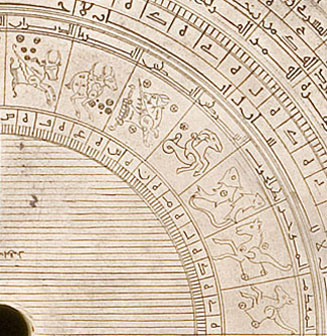| Date | 1227/8 (A.H. 625) |
| Maker | ‘Abd al-Karīm al-Miṣrī |
| Place | Cairo (?) |
| Material | Brass |
| Inventory no. | 37148 |
| Acquisition | Presented by Lewis Evans in 1924 |
This magnificent astrolabe, one of the few surviving from the Ayyubid period (the dynasty founded by Saladin), represents a high point in the history of metallurgical craftsmanship. It is decorated by gold and silver damascening, an inlay process which takes its name from Damascus. The astrolabe was made to the order of the sultan Abū-l-Fātih Mūsā, Saladin's nephew, who ruled over parts of Mesopotamia (Iraq), Syria, and Armenia in the 1210s and 1220s. An inscription rehearsing about thirty honorific titles and terms of praise for him is minutely inlaid in gold around the entire front rim.
A remarkable feature of the technical content of this astrolabe is the set of lunar mansions found on the back. While many astrolabes include a list of lunar mansions, the pictorial representations found here make it unique and provide valuable clues to its use. The lunar mansions on this instrument reflect the standard Arabic names of the mansions and their order. In each case, some attempt has been made to indicate the stars that were associated with each mansion. However, the entire cycle seems to have been rotated three mansions counterclockwise from where it normally begins. In the picture, the mansions proceed counterclockwise from the winged horse (المقدم — al-Muqqadam) in the lower right to the bull at the top. If this were a typical set of lunar mansions, the winged horse would be the first mansion, corresponding to the first point of Aries. In this case, al-Muqqadam is the twenty-sixth mansion; the first lunar mansion (الشرطين — al-Sharaṭayn) is the fourth mansion in this picture, represented by the ram-like figure.
These pictograms link the lunar mansions and this astrolabe to a rich astral magic tradition. Numerous Arabic texts associate the lunar mansions with talismans, which were used in all manner of magic, both beneficial and harmful. These texts circulated throughout the Arabic-speaking world and were, at the time this instrument was made, also being translated into Spanish. The cycle of lunar mansions, with its link to a magical tradition, reinforces this astrolabe's terrestrial and pragmatic uses, including astral medicine and love magic.
View all
images for this astrolabe
View
detailed provenance for this astrolabe
Mater
The mater and limb are of one-piece construction. The limb is cracked at the bottom of the instrument, 180° from the throne. This is the location of the notch that accepts the tympan tabs. Scales on the limb: degree scale.The limb is inscribed: with a marked as [along entire limb]. [ pending ]. More information
Back
The back contains 13 scales of the following types: Degree; Zodiacal signs; Terms; Faces; Triplicities; Calendar; Lunar Mansions; Altitude; Cotangent; Unequal hours; Shadow square. The back is inscribed: with a maker's signature marked as للملك الأشرف صنعه عبد الكريم المصري الأصطرلابي في سنة خكه الهجرية (Made by the astrolabist ʿAbd al-Karīm al-Miṣrī, to al-Malik al-Ashraf in the year 625 A.H.). Inscription below and to the left of the central hole. More informationRete, Pin & Horse
The rete contains 29 stars. The rete contains zoomorphs: a bird pointer indicates vega. The zodiac on the rete is labelled: الحمل , الثور , الجوزا , السرطان , الاسد , السنبله , الميزان , العقرب , القوس , الجدي , الدلو , الحوت .The rete is inscribed with a date marked as: في سنة ضكد الهجرية (...) وذصد اليزجرديةة (In the year 824 of the Hijra and the year 794 of the Yazdegerd era.). Inscription on right and left segments of horizontal bar.The rete is attached using a pin & horse. The head of the pin resembles a flower. The horse is an accurate representation.. More information
Rules & Alidades
| Type | Details |
|---|---|
| Alidade | Double-ended. Both tips are decorated with silver
inlay. There are two scales, one of fingers and one of
feet, on the fiducial edge of this alidade. |



